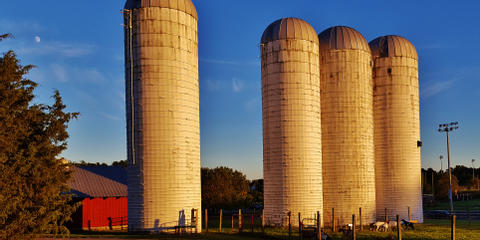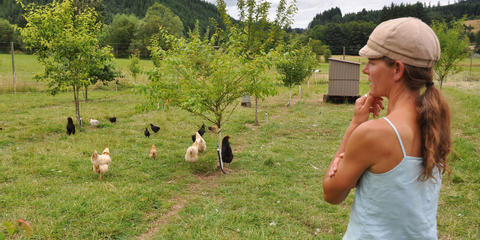Federal funding programs are under review as of 1/27/25. We'll make updates as new info is released.
The Environmental Quality Incentives Program (EQIP) provides financial and technical assistance to agricultural producers to address natural resource concerns and deliver environmental benefits such as improved water and air quality, conserved ground and surface water, increased soil health and reduced soil erosion and sedimentation, improved or created wildlife habitat, and mitigation against drought and increasing weather volatility.
How It Works
This voluntary conservation programs helps producers make conservation work for them. Together, NRCS and producers invest in solutions that conserve natural resources for the future while also improving agricultural operations.
Through EQIP, NRCS provides agricultural producers with financial resources and one-on-one help to plan and implement improvements, or what NRCS calls conservation practices. Using these practices can lead to cleaner water and air, healthier soil and better wildlife habitat, all while improving agricultural operations. Through EQIP, you can voluntarily implement conservation practices, and NRCS co-invests in these practices with you.
Benefits
Some of these benefits include:
-
Reduction of contamination from agricultural sources, such as animal feeding operations.
-
Efficient utilization of nutrients, reducing input costs and reduction in non-point source pollution.
-
Increased soil health to help mitigate against increasing weather volatility and improved drought resiliency.
2018 Farm Bill EQIP Updates
Historically underserved (HU) participants are eligible for advance payments to help offset costs related to purchasing materials or contracting through EQIP. HU participants may elect to receive an advance of not less than 50 percent of the EQIP conservation practice payment amount. If the participant elects to receive the advance payment, the funds must be expended within 90 days of receiving the advance.
The 2018 Farm Bill expanded eligibility regarding with whom NRCS can enter into an EQIP contract. NRCS may enter into EQIP contracts with water management entities when they are supporting a water conservation or irrigation efficiency project. These entities are defined as State, irrigation district, ground water management district, acequia, land grant-merced, or similar entity.
The 2018 Farm Bill requires a national 10 percent of mandatory program funding be targeted towards source water protection. States will identify priority source water protection areas and may offer increased incentives and higher payment rates for practices that address water quality and/or water quantity.
Beginning in 2020, States may provide increased payment rates for high-priority practices. In consultations with the State Technical Committee, State Conservationists may designate up to 10 practices to be eligible for increased payments. Eligible high-priority practices include those that address specific causes of ground or surface water impairment relating to excessive nutrients, address the conservation of water to advance drought mitigation and declining aquifers, meets other environmental priorities and other priority resource concerns identified in habitat or other area restoration plans, or is geographically targeted to address a natural resource concern in a specific watershed.
EQIP Incentive Contracts
The 2018 Farm Bill introduced EQIP incentive contracts to expand resource benefits to producers through incentive practices such as cover crops, transition to resource conserving crop rotations and precision agriculture technologies along with a similarly broad suite of incentive practices for ranchers and non-industrial private forest operators. Every region within a State will have identified high-priority areas and each of these areas will target up to three priority resource concerns by land use. In addition to the payment for practice implementation, incentive contracts offer annual payments to address operations and maintenance costs as well as foregone income. EQIP incentive contracts can be a stepping stone for producers between EQIP classic and Conservation Stewardship Program (CSP) contracts.
You can visit the 2018 Farm Bill Programs page for for more information about other NRCS conservation opportunities.
Popular Practices
EQIP Initiatives
Targeted EQIP financial assistance is available through general EQIP, and several other initiatives. These initiatives address priority natural resource concerns on the most vulnerable lands, target conservation assistance in high priority watersheds, or help stimulate the development and adoption of innovation and technology. Learn about Landscape Conservation Initiatives here.
Eligibility
Eligible land includes:
-
Cropland and hayland
-
Rangeland
-
Pastureland
-
Non-industrial private forestland
-
Other farm or ranch lands
-
Environmentally sensitive areas
Eligible applicants(s) include:
-
Agricultural producers
-
Owners of non-industrial private forestland
-
Indian Tribes
-
Those with an interest in the agricultural or forestry operations
-
Water management entities
Application Instructions
To learn more about EQIP, contact your local NRCS office. Visit the Apply for EQIP page for more information on what to expect.
An NRCS conservationist will visit you and evaluate the natural resources on your land. NRCS will then present a variety of conservation practices or system alternatives to help you address those concerns or management goals to improve or protect the natural resource conditions on your land. At some point, you will likely need to complete the EQIP application form below.
Applications for EQIP financial assistance are accepted throughout the year, but specific deadlines are set for ranking and funding opportunities within each state. We therefore recommend you apply as soon as possible to maximize acceptance into EQIP before your state's next funding deadline.
Forms
Resources
Related Programs

Farm Storage Facility Loan Program (FSFL)
Farm Service Agency
- Loan
- Infrastructure
- Equipment
- Storage
- Lighting
- Delivery Vehicle
- National
- Oilseeds
- Peanuts
- Pulse Crops
- Hay
- Honey
- Biomass
- Fruits
- Vegetables
- Floriculture
- Hops
- Maple Sap
- Milk
- Cheese
- Yogurt
- Butter
- Eggs
- Rye
- Aquaculture
- Poultry
- Livestock
- Grains

A Climate-Smart Strategy for the Michigan Foodshed
Star of the West Milling Company, U.S. Department of Agriculture
- Grant
- Climate-Smart
- Beginning Farmers
- Women
- MI
- Wheat
- Dried Beans
- Soybeans

A Comprehensive Evaluation of the Impact of Industrial Hemp and Soil Microalgae Consortium as High-Efficiency Carbon Sequestration Model Plants
Florida A&M University, U.S. Department of Agriculture
- Grant
- Climate-Smart
- AL
- FL
- LA
- Hemp

A Multi-Faceted Approach to Incentivizing Woody Perennial Growers to Establish Cover Crops in Orchards in Four Diverse Regions of the United States
Agoro Carbon Alliance US, U.S. Department of Agriculture
- Grant
- Climate-Smart
- CA
- WA
- OR
- MI
- FL
- Fruits
- Tree Nuts
Details
Tags
- ConservationCover CropsForest ManagementCertified GrassfedIrrigationHigh TunnelCertified OrganicAir QualityAlternative EnergySoil HealthWildlife & Pollinator HabitatWater QualityWeatherResearchLandscapePrecision AgDroughtNutrient ManagementCarbon CaptureFencingAgroforestryGrazing ManagementReduced Inputs
Organization
Financial Instrument
Grant, Cost Share
Updated May 28, 2025
Image Credit: NRCS Oregon
This information was gathered from public sources. Ambrook is not responsible for or able to affect the results of any financial programs listed, nor are they responsible for any incorrect information that is listed or is on the hyperlinked external sites. All information is subject to change.
Explore hundreds more programs on Ambrook.
